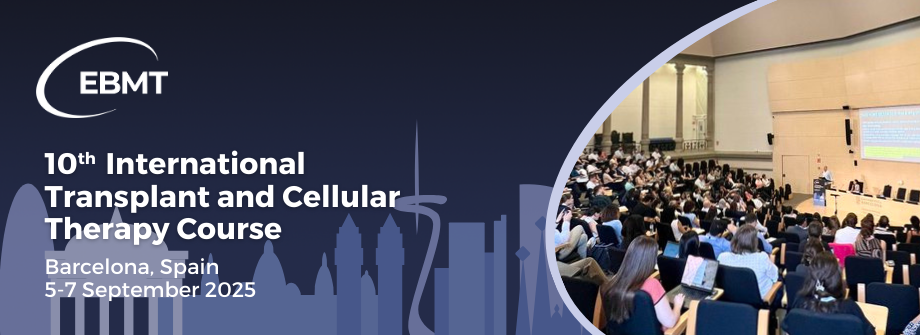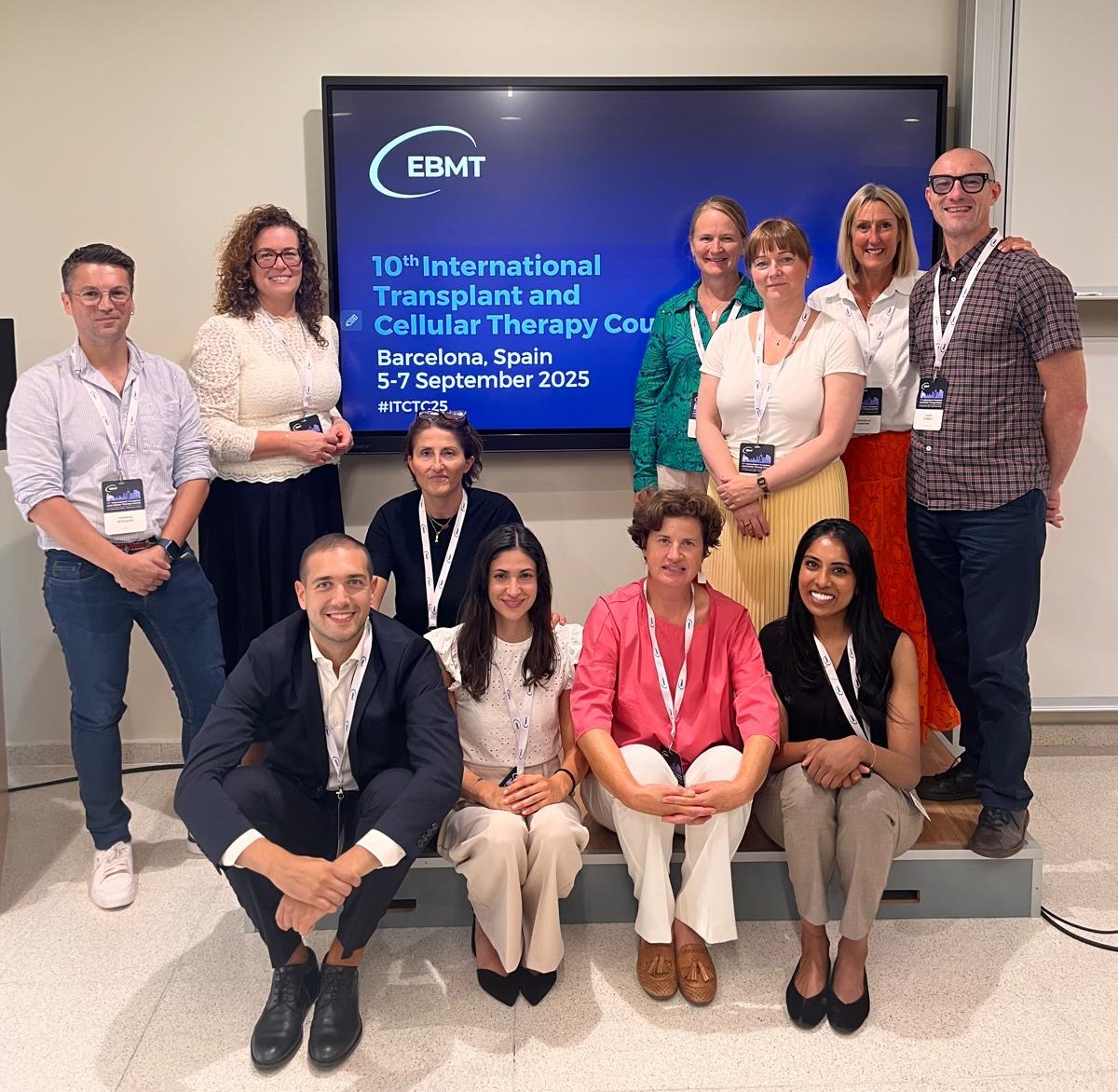
5-7 September 2025, Barcelona, Spain
Nurses’ Track
Summary report written by Davide Bonomi, Claudia Boglione, Anna Serrahima, and Sólveig Adalsteinsdóttir.
Session I: Preparation, cell collection, conditioning and infusion
The first session of the Nurses’ Track started with the President of the Nurses Group, Hilda Mekelenkamp, who set the scene for the day’s session. Following that, Annika Kisch took us into one of the most crucial elements of transplantation: identifying the right donor, for the right patient, at the right time. She addressed how donor matching and timing are key determinants for success. Next, Davide Bonomi, member of the NG Scientific Committee, guided us through the pre-transplant phase. His presentation provided a comprehensive overview of what patients and professionals need to know before entering the transplantation pathway. We then heard from Marijke Quaghebeur, Chair of the NG Scientific Committee, who explored the different conditioning regimens. She explained the rationale behind these approaches and how tailoring the regimen to the patient and disease can influence outcomes. After that, Sandrine Bremathas discussed infusion strategies, comparing stem cells, CAR-T, and lymphocytes. This talk aimed to underline the differences between these therapies, their unique challenges, and future perspectives. Finally, Sólveig Adalsteinsdóttir, member of the NG Scientific Committee, closed the session with a focus on central venous catheters, presenting evidence on best practices. Her contribution brought us back to the practical aspects of care that ensure safety and effectiveness throughout the transplantation process.
Session 2: Post-Infusion Care
The second session of the day focused on post-infusion care, and we heard four interesting presentations on nutrition, infections, early complications, and tips for writing an abstract effectively. Katie Ahern, special dietitian in hematology and stem cell transplantation, reminded us of the importance of proper nutrition during hospitalization, managing this difficult period for the patient who may be overwhelmed by nausea, isolation, and in some centers, a low-microbial load diet. She emphasized that this approach is now obsolete, and instead we should focus on meal hygiene and food preservation. Thomas Jezequel, advanced nurse practitioner in the pediatric hematology unit at the University Hospital of Nantes and member of the Scientific Committee of the EBMT Nurses Group, gave us an update on all the infections that our patients usually encounter and how to carry out good health surveillance to be able to intercept and perhaps prevent them. Anna Serrahima Mackay, hemato-oncology nurse, specializing in transplant care, unit management, and JACIE accreditation, and member of the Scientific Committee of the EBMT Nurses Group, updated us on the guidelines for the various early complications of transplantation. Hilda Mekelenkamp, gave some excellent suggestions on how to write a good abstract that can be accepted by the committee, especially to be able to give voice to the hard work done.
Session 3: Transplant Complications
After the lunch break, the Nurses’ Track continued with a session dedicated to long-term complications after transplant, with the participation of two past presidents of the Nurses Group: John Murray and Michelle Kenyon. The first part was dedicated to GVHD (acute and chronic), where Silvia Gnecchi reviewed the latest literature on the topic and described forms of presentation organ by organ. John Murray highlighted the importance of asking patients how they feel to promptly detect chronic forms of GVHD, as well as the need for using self-reported screening tools and experienced medical evaluations. The session was followed by a virtual talk where Ibe de Quick outlined the different options available for preserving fertility in both men and women, as well as strategies for conceiving, including through ovarian tissue transplantation. The session ended with Michelle Kenyon talking about long-term adverse effects and how survivors or long-term survivors cope with their new normal—not without complications or increased risks to their health.
Session 4: Essential update
Hilda Mekelenkamp shared recent data on pediatric transplantation, with over 5,000 children transplanted. She discussed conditioning regimens, highlighting TBI/Etoposide for older children with HR-ALL and Flu/Tio/Bu or Flu/Tio/Treo for younger HR-ALL, and non-malignant patients. She also presented figures on CAR-T therapy in children and gene therapy trials, noting both the benefits and challenges. She emphasized the importance of involving pediatric patients in decision-making, the role of family-centered care, the complexities of ICU admissions and palliative care, and the transition to adult care.
Claudia Boglione, the ADWP link nurse and local nurse of our Annual Meeting in Florence, began by going over the criteria for autoimmune diseases. There are different types, but they all stem from the immune system failing to recognize the body’s own structures and cells. These diseases are chronic and progressive, threatening survival and quality of life, often in mid-life. Standard care typically involves immunosuppressants and anti-inflammatory therapy. CAR-T cell therapy for this group of patients could restore normal immune function, referred to as an immune reset. It modulates and reprograms the immune system, preventing it from attacking healthy tissue. The treatment is the same as for malignant disease, and efficacy has been shown for up to 2–3 years to date. There is a low risk for CRS and ICANS, and long-term safety is promising. The diseases most studied are systemic sclerosis (SSc), multiple sclerosis (MS), and myasthenia gravis. More studies are needed, and new variants of CAR-T cells are emerging, giving hope for more options for this group of patients.
Overall, the Nurses’ Track provided great presentations on the most important basics for nurses working in the field of HCT and CT. This course is a solid preparatory course, in addition to the EBMT Textbook for Nurses, for the first Nurses Exam during the Annual Meeting in Madrid in 2026.

Paediatrics’ Track
Summary report written by Benedetta E. Di Majo.
The 10th EBMT International Transplant and Cellular Therapy Course (ITCTC) was held in Barcelona, Spain, from 5 to 7 September 2025, bringing together physicians, nurses, researchers, and industry partners for three days focused on advances in haematopoietic cell transplantation (HCT) and innovative cellular therapies. A dedicated paediatric track on the second day emphasized recent progress in the management and care of children.
The paediatric track opened with Session I on paediatric leukaemia, chaired by Krzysztof Kalwak (Poland), head of the EBMT PDWP, and Benedetta E. Di Majo (Italy), a member of the PDWP Young Investigators Subcommittee. The first speaker, Krzysztof Kalwak, gave an engaging overview of total body irradiation (TBI) versus chemotherapy-based conditioning regimens in HSCT for acute lymphoblastic leukaemia (ALL) in children. TBI remains a highly effective therapy for children over 4 years of age; however, late side effects – including secondary malignancies and endocrine disorders – must be taken into account. Future directions, such as the safety and efficacy of TBI in children aged 2 to 4 years, will be clarified by the results of the FORUM 2 trial.
The session continued with an excellent state-of-the-art overview of CAR-T cell therapy for B-ALL, presented by Giovanna Lucchini (Italy). She addressed unresolved questions including the optimal timing of CAR-T therapy as a bridge to HSCT, strategies to prevent CD19-positive relapse and lineage switch through dual-targeting CAR-T cells, and the evolving role of HSCT following CAR-T infusion.
Dominik Turkiewicz (Sweden) followed with a compelling presentation on current evidence for HSCT in acute myeloid leukaemia (AML), discussing graft source selection, conditioning regimens – with or without therapeutic drug monitoring – and the importance of measurable residual disease (MRD). He concluded with an engaging discussion of preliminary results from the NOPHO-DBH AML 2012 protocol.
The final topic in this session was presented by Herbert Pichler (Austria), who shared insights on the role of HSCT in chronic myeloid leukaemia (CML) in the era of tyrosine kinase inhibitors (TKIs). Key questions remain around whether reduced-intensity regimens improve outcomes and whether patients with TKIs resistance should proceed directly to transplantation.
The session closed with an excellent case presentation by José Antonio Flores (Spain), highlighting porto-sinusoidal vascular disease as a rare but severe complication of allogeneic HSCT, underscoring the importance of long-term vascular monitoring in these patients.
Session II, focused on HSCT and gene therapy (GT) in primary immunodeficiencies (PIDs) and inborn errors of metabolism (IEMs), was chaired by Maria Ester Bernardo (Italy) and Anna-Lisa Lanz (Germany). Bénédicte Neven (France) opened with a comparison of haploidentical HSCT platforms in PIDs. She reported comparable survival outcomes between TCRαβ/CD19 depletion and post-transplant cyclophosphamide (PTCy), though the latter was associated with a higher incidence of mild graft-versus-host disease (GVHD), endothelial toxicities, and slightly delayed engraftment – likely due to cyclophosphamide-related recovery time. She also shared insights from Necker’s experience using PTCy in 81 non-severe combined immunodeficiency (non-SCID) patients.
Maria Ester Bernardo, chair of the EBMT IEWP, continued with a discussion on therapeutic options and challenges in IEMs. GT offers several advantages, such as bypassing donor availability and GVHD, while often resulting in enzyme overexpression. The current standard of care includes allogeneic HSCT for mucopolysaccharidosis type 1 Hurler, X-linked adrenoleukodystrophy, and Krabbe disease. GT is already approved for cerebral-adrenoleukodystrophy and metachromatic leukodystrophy. A key takeaway was the importance of implementing newborn screening programs to enable early diagnosis and timely treatment.
Claire Booth (UK) concluded the session with a broad overview of GT for PIDs – ranging from SCIDs to lentiviral GT for non-SCIDs – and highlighted new frontiers such as T-cell GT and gene editing. Major challenges – including gene insertion efficiency, costs, and global accessibility – were also discussed.
Session III, chaired by Luca Vinci (Germany) and Su Han Lum (UK), resumed in the afternoon. Su Han Lum opened with an excellent presentation of real-world data on HSCT for Fanconi anaemia in over 800 children, showing comparable survival rates with matched family or unrelated donors. Event-free survival was improved in younger children, while outcomes were poorer in those with AML or myelodysplastic syndrome (MDS).
Luca Vinci followed with a comprehensive overview of HSCT indications for refractory cytopenia of childhood and germline syndromes predisposing to MDS, especially GATA2 and SAMD9/SAMD9L mutations. He also addressed juvenile myelomonocytic leukaemia (JMML), highlighting how outcomes are influenced by genetic mutations, DNA hypermethylation, and pre-HSCT haemoglobin F (HbF) levels, which correlate with methylation status.
The session concluded with a unique, well-presented case by Paula Mazorra Roig (Spain), involving a child with Fanconi anaemia who developed severe cutaneous GVHD post-HSCT, in the context of HSV-1 infection and vitamin C deficiency–related impaired tissue repair.
Session IV, the final of the day, was chaired by Esraa Khalil (Oman) and Josu de la Fuente (UK), who opened with a discussion on current indications for HSCT versus GT in sickle cell disease (SCD), with a focus on emerging gene editing techniques such as CRISPR/Cas9.
Mattia Algeri (Italy) followed with a presentation on HSCT in transfusion-dependent thalassemia (TDT), highlighting excellent outcomes using either PTCy or TCRαβ/CD19 depletion in haploidentical settings. GT experiences with Beti-cel and Exa-cel were also reviewed, reflecting a shift from protocol-driven to patient-centred care.
Catherine Mhando (Tanzania) gave a highly engaging presentation on 20 patients with SCD who underwent HLA-matched sibling HSCT at a newly established unit in Tanzania. Outcomes were outstanding, with all patients maintaining transfusion independence and achieving HbS levels consistent with full engraftment.
The paediatric track concluded with Lucas Anastacio (Brazil), who presented a challenging case linking cerebral infarcts to microembolic events in a patient with SCD who developed infective endocarditis after allogeneic HSCT.
In summary, Paediatric Day was very well-attended, full of vivid discussions, and, without a doubt, a highlight of this already highly informative and engaging course for all paediatric transplant professionals and trainees.